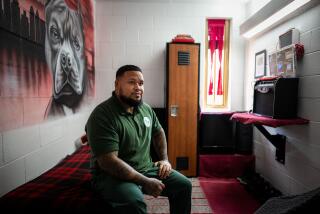Viking Ship to Re-Create Feat of Leif Ericsson
- Share via
PHIPPSBURG, Maine — Plank by plank and rivet by rivet, boat builders on the Maine coast are completing a 54-foot Viking ship that will re-create a 1,000-year-old adventure.
By late April, if all goes as planned, they will have finished an exact replica of a knarr, the type of merchant vessel used by explorer Leif Ericsson when he established what is believed by many to be the first contact between Europe and North America.
Following sea trials, the square-rigged boat will be taken to Greenland, where a 12-member crew will attempt to retrace Ericsson’s voyage, relying as he did on only the sun and stars for navigation.
Viking Voyage 1000 is the brainchild of W. Hodding Carter, a West Virginia writer whose fascination with the exploits of Viking adventurers dates from books he read during childhood.
“This is a way to indulge these fantasies,” Carter said. “It’s a way of capturing what was a pivotal moment in history. By going out there and doing it, I get the chance to experience what it really was like.”
This isn’t the first such adventure for Carter, the 34-year-old son of former State Department spokesman Hodding Carter, a familiar face to TV viewers during the 1980 Iran hostage crisis.
The younger Carter’s earlier attempt to retrace the steps of two land-based American explorers provided the basis for his humorous book “Westward Whoa! In the Wake of Lewis and Clark.”
Construction of the open-deck boat, built from four varieties of wood held together with iron rivets, began last October at Robert Stevens’ boatyard on Hermit Island.
Amid piles of sawdust and the reek of pine tar, the boat is taking shape. Stevens and six builders are racing to meet a deadline for an April 23 launch so the vessel can complete sea trials and begin its 1,800-mile journey in early July.
After cutting the keel and stems from Maine-grown oak, the builders shaped 20-foot planks of Carolina pine, some weighing more than 200 pounds.
The planks are heated for up to five hours in a jerry-built outdoor steamer, so they can be bent and clamped onto the frame.
Timing is essential: The crew has only a two-month window from the breakup of the ice pack that now covers Ericsson’s route until the onset of hurricane season.
Departing from the site in southwestern Greenland where the explorer’s father, Eric the Red, had a farm, the knarr will sail about 600 miles up the Greenland coast before crossing the Davis Strait to Baffin Island.
The boat will then continue down the Baffin Island coast and on to Labrador before reaching its final destination, L’Anse aux Meadows, on the northern tip of Newfoundland. It was there in about the year 1000, historians say, that Ericsson established the settlement he called Vinland because of the area’s wild grapes.
Eventually, the settlement was abandoned, and Ericsson’s accomplishment remains overshadowed by Columbus’ voyage 500 years later.
The trip is expected to take six to eight weeks and will include one- or two-day stops along the shore every other day or so. Besides offering a respite from the boat’s cramped conditions, the visits will let the crew meet with Greenlanders and Canadian Inuits and to forage for provisions, as did the Vikings earlier.
Unlike the original Vikings, however, those on Carter’s boat will neither loot nor pillage.
“We’re replicating the much gentler type of Viking, so we will be begging for our food from the kindly Inuit,” he said.
Carter is leading the trip, but he has chosen Outward Bound instructor Terry Moore as the boat’s captain and will defer to him on sailing and safety matters. The boat will have a radio, compasses, a sextant and a global positioning satellite system, all to be used only in an emergency.
The wind in the square canvas sail will propel the boat in open water, but crew members will man the six oaring stations when it becomes necessary to maneuver close to shore.
Last fall, Stevens and Carter spent 10 days in Scandinavia, where they studied the remains of sunken Viking ships at a Danish museum and returned with plans for their own knarr.
The cost of the project, which Carter puts in the hundreds of thousands of dollars, is being underwritten by Lands’ End, the Wisconsin mail-order clothing company that got its start by selling foul-weather gear to recreational sailors.
Lands’ End will chronicle the adventure in its catalogs. Carter plans to write a book about it, and New York photographer Russell Kaye will be taking photos for a second book.
The boat itself will remain at the spot of Ericsson’s landfall. Carter said his New Vinland Foundation, which is raising money for the trip, intends to donate the vessel to a park at L’Anse aux Meadows in hopes of drumming up interest in the historic site.
More to Read
Sign up for The Wild
We’ll help you find the best places to hike, bike and run, as well as the perfect silent spots for meditation and yoga.
You may occasionally receive promotional content from the Los Angeles Times.






